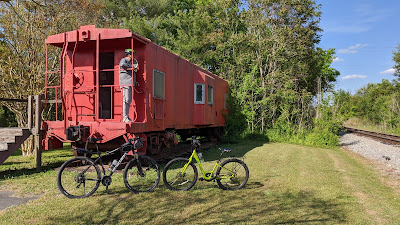- Dates Hiked: April 14, 19, 27,and May 26, 2020
- Posted length: n/a
- Total miles Tracked: 4/14/2020: 2 miles; 4/19/2020: 3.7 miles; 4/27/2020: 1.75 miles, 5/26/2020: 2.5 miles
- Type of Trail: gravel and dirt roads, foot trails
- Conveniences: Close to home
- Best Features: Solitude
- Worst Features: No water, no parking
- Wildlife spotted: song birds, tortoise, winged insects
- Vegetation: Pines and hardwoods, wildflowers
- Associated Website: https://dukeforest.duke.edu/
- Primary Author: Cheryl
This spring, as Covid-19 has shut our world down, more people have also ventured outside for exercise and vitamin D. This became increasingly difficult as state and local parks had to shut their gates due to over-crowding and the inability for people to practice social distancing. We are very lucky that in addition to the abundance of state parks we have here in this area, we also have a multitude of other trails at our disposal - if you just know where to find them.
James and I have spent a lot of time walking and exploring the many different divisions of Duke Forest. We almost hate to share this gem of a trail right here in Hillsborough, but it's so worth checking out. In four times we've gone and hiked this one trail, we've only encountered one other person. Social distancing for the WIN!
 |
| We're sure that the name "Snake Foot Trail" is in no way connected to the lack of visitors. |
The purpose of Duke Forest is not for recreation. It is a cumulative total of over 7000 acres of a large outdoor laboratory for research that has been in operation for nearly 90 years, and has land in Durham, Orange and Alamance Counties. While Duke Forest stresses education and research, they know the land is also well loved by the community for hiking (and on some gravel roads in some of the divisions, for biking). Because Duke Forest has experienced an increase of usage of the roads and foot trails during this pandemic, they're gathering stories and personal reflections from the public to document what the Forest has meant to the users. Go to the link above to find the survey. Always researching!
This section of the Hillsborough Division is off of the connector between north bound I-85 and Highway 70 East. There is just enough room for 2 cars to park on either side of the gate. Most of our recent hikes here have been in the evening, as the sun casts long shadows through the old growth.
The traffic from the nearby interstate is audible, but that is easily shut out while you search for the remnants of old paved roads along the foot trails. Snake foot trail loops around and intersects with the Old Quarry Road, then you're routed back to Cates' Road to complete your loop.
Look for all the winged creatures.
And check out what's booming above your head and below your feet.







































